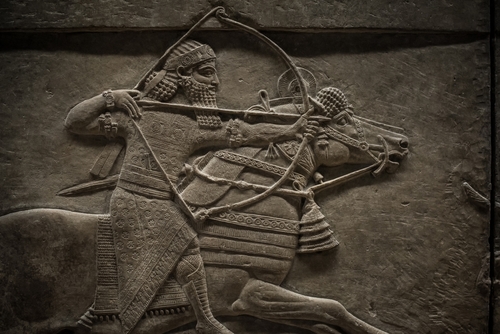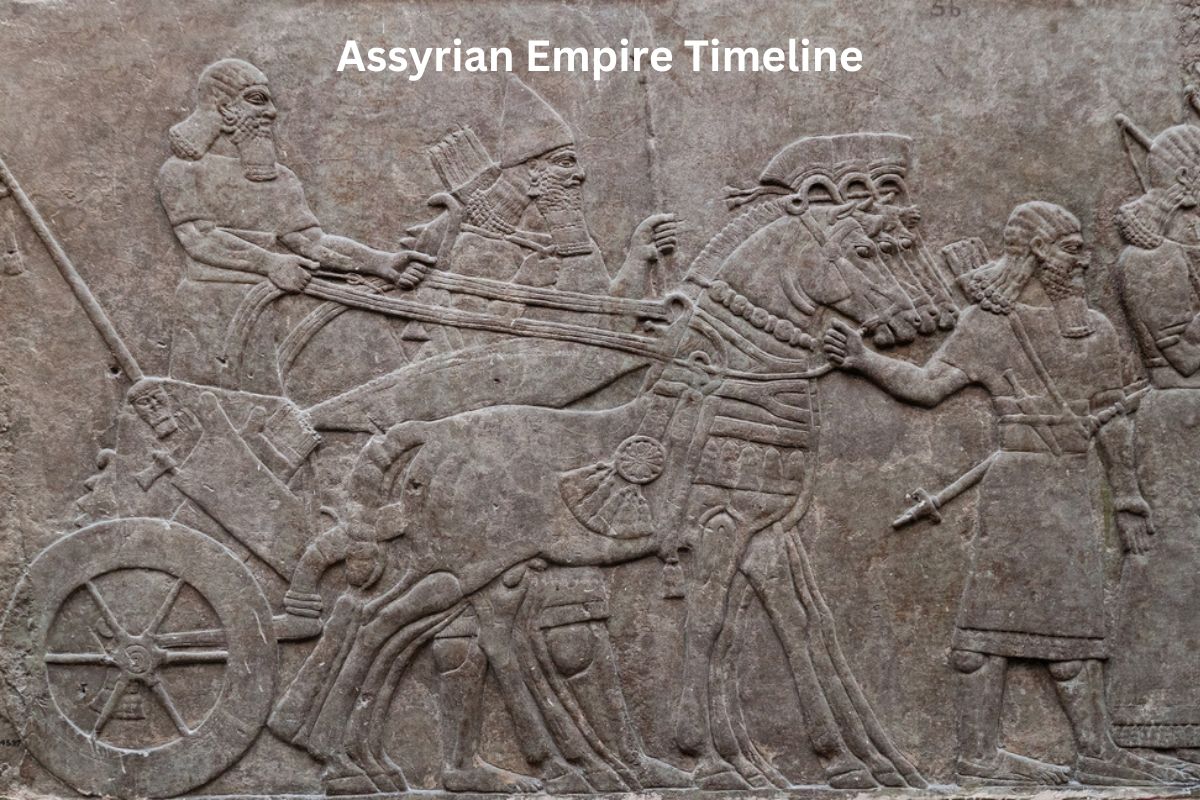The Assyrian Empire, also known as the Assyrian Civilization, was one of the earliest and most powerful empires in human history.
Originating from the city of Assur (or Ashur) in modern-day northern Iraq around 2000 BC, the empire spanned three distinct phases: the Old Assyrian Empire (c. 2000–1364 BC), the Middle Assyrian Empire (c. 1365–1056 BC), and the Neo-Assyrian Empire (c. 911–609 BC).
Known for their advancements in many fields such as warfare, governance, art, and architecture, the Assyrians were particularly noted for their ruthless military tactics and wide use of psychological warfare.
The Assyrian Empire was the largest empire the world had seen up until that time, and its influence on the broader region of the Near East was profound.
The Old Assyrian Empire established itself through trade and modest territorial expansion. The Middle Assyrian Empire, on the other hand, marked a period of territorial expansion and military dominance, while the Neo-Assyrian Empire represented the peak of Assyria’s power, with significant territorial conquests and impressive cultural achievements.
Also Read: Assyrian Accomplishments
The Assyrian Empire ultimately fell in 609 BC after the Battle of Harran and the loss of its capital, Nineveh, to a coalition of Babylonians, Medes, and Scythians. Despite its downfall, the empire left behind a rich cultural and historical legacy.
| Period | Date | Event |
|---|---|---|
| Old Assyrian Empire | 2025 BC | Assyrian city-state of Assur gained its independence |
| 2000 BC | Establishment of the Old Assyrian Empire | |
| 1813 BC | Start of King Shamshi-Adad I’s reign | |
| 1750 BC | Decline of the Old Assyrian Empire due to Hammurabi’s rise in Babylon | |
| 1364 BC | Reign of Ashur-uballit I, last king of the Old Assyrian Empire | |
| Middle Assyrian Empire | 1365 BC | Ashur-uballit I established the Middle Assyrian Empire |
| 1274 BC | Battle of Kadesh between the Hittites and Egyptians | |
| 1245 BC | King Tukulti-Ninurta I conquered Babylon | |
| 1056 BC | End of the Middle Assyrian Empire with the reign of Tiglath-Pileser I | |
| Neo-Assyrian Empire | 911 BC | Start of the Neo-Assyrian Empire with Adad-nirari II |
| 745 BC | Tiglath-Pileser III’s reign, marking significant military expansion | |
| 722 BC | Fall of the Kingdom of Israel to the Assyrian Empire | |
| 705 BC | Sennacherib became king of Assyria | |
| 701 BC | Sennacherib’s campaign against Judah | |
| 681 BC | Esarhaddon became king of Assyria | |
| 669 BC | Ashurbanipal became king of Assyria, marking the empire at its height | |
| 627 BC | Death of Ashurbanipal, marking the beginning of the fall of the Neo-Assyrian Empire | |
| 612 BC | Destruction of Nineveh, the Assyrian capital | |
| 609 BC | Battle of Harran, marking the end of the Assyrian Empire |
Timeline of the Assyrian Empire
2025 BC – Assyrian city-state of Assur gained its independence
The city of Assur (or Ashur), located on the Tigris River in modern-day northern Iraq, was originally a Sumerian settlement.
However, it came under the control of the Akkadian Empire when Sargon of Akkad united the Sumerian and Akkadian peoples of Mesopotamia. When the Akkadian Empire fell, the city-state of Assur gained its independence.
Also Read: Assyrians Facts
Assur became a center of trade and a conduit for cultural exchange between Mesopotamia and Anatolia (modern-day Turkey) due to its strategic location.

2000 BC – Establishment of the Old Assyrian Empire
The establishment of the Old Assyrian Empire began around 2000 BC when Assur developed into a city-state. It was a period of expansion for the city, often through trade.
The most prominent trade colony was at Karum Kanesh in Anatolia. Assyrian merchants there traded textiles and tin from Assur for gold and silver. This wealth allowed the kings of Assur to build up an army and start territorial expansion, thus marking the establishment of the Old Assyrian Empire.
During this period, the Akkadian language of the Assyrians became the international language of trade and diplomacy, similar to how English is used today. This was also a period where we see the first extensive use of writing for commercial, legal, and administrative purposes in the region.
1813 BC – Start of King Shamshi-Adad I’s reign
Shamshi-Adad I is known as one of the great kings of the Old Assyrian Empire. He took advantage of the disintegration of the Third Dynasty of Ur to expand his territories, creating an empire that stretched from the Mediterranean Sea to the Zagros Mountains.
During his reign, he greatly improved the administrative and political structure of the empire and established his sons as rulers of strategic cities.
1750 BC – Decline of the Old Assyrian Empire due to Hammurabi’s rise in Babylon
Hammurabi, the sixth king of the First Babylonian Dynasty, was a contemporary of the Old Assyrian Empire. As Hammurabi rose to power, he transformed Babylon from a small city-state into a major empire, known today as the Old Babylonian Empire.
During his reign, Hammurabi conquered many surrounding city-states, including Assur. His conquests and the expansion of Babylon’s influence led to a decline in the power of the Old Assyrian Empire.
1364 BC – Reign of Ashur-uballit I, last king of the Old Assyrian Empire
Ashur-uballit I is credited with founding the Middle Assyrian Empire, but he was also the last king of the Old Assyrian Empire. His reign marked a period of military expansion and centralization of political power.
Ashur-uballit I broke the control of the Babylonians over the Assyrians and initiated a program of conquest, bringing a large territory under direct Assyrian rule.
1365 BC – Ashur-uballit I established the Middle Assyrian Empire
As previously mentioned, Ashur-uballit I broke free from Babylonian control and initiated the Middle Assyrian Empire. During this period, Assyria became one of the most powerful kingdoms in the Near East.
The empire expanded its territory through military conquests, which included territories of the Hittites, Babylonians, Mitanni, and the Hurrians. Ashur-uballit I also formed a diplomatic marriage alliance with the Egyptian Pharaoh, which bolstered Assyria’s international standing.
The Middle Assyrian Empire was characterized by strong kings who consolidated power through military strength, strategic alliances, and administrative reforms.
1274 BC – Battle of Kadesh between the Hittites and Egyptians
The Battle of Kadesh was one of the most significant and best-documented battles of the ancient world, primarily fought between the Egyptian Empire under Pharaoh Ramses II and the Hittite Empire under Muwatalli II.
While the Assyrian Empire was not a direct participant, this conflict among its powerful neighbors allowed Assyria to remain a prominent third party in the region. Assyria’s ability to maintain its power amidst the shifting balance was crucial for the continuation and growth of the empire.
1245 BC – King Tukulti-Ninurta I conquered Babylon
Tukulti-Ninurta I was a powerful king of the Middle Assyrian Empire. He conducted a successful military campaign against the Kassite-controlled Babylonian Empire, leading to his capturing of Babylon’s king and his assumption of the title “King of Sumer and Akkad.”
He moved many religious artifacts from Babylon to Assur, including the sacred statue of Marduk. This was a significant achievement, but it was also controversial and led to internal strife within Assyria.
1056 BC – End of the Middle Assyrian Empire with the reign of Tiglath-Pileser I
Tiglath-Pileser I was one of the last powerful kings of the Middle Assyrian Empire. He was known for his military campaigns that expanded Assyrian control into Anatolia (modern Turkey) and the Levant.
However, after his death, the Assyrian Empire went through a period of decline due to internal rebellions and external threats. This period marked the end of the Middle Assyrian Empire.
911 BC – Start of the Neo-Assyrian Empire with Adad-nirari II
After several centuries of relative weakness and instability, the Assyrian Empire began to regain its strength under the rule of Adad-nirari II, marking the beginning of the Neo-Assyrian Empire. He conducted several successful military campaigns and implemented administrative reforms that revitalized the empire.
745 BC – Tiglath-Pileser III’s reign, marking significant military expansion
Tiglath-Pileser III was a crucial figure in the Neo-Assyrian Empire. He undertook significant military campaigns, reorganizing the army and the empire’s administrative structure.
He is also credited with introducing the policy of deporting conquered peoples, a hallmark of the Neo-Assyrian Empire. His reign marked a significant expansion of the empire.
722 BC – Fall of the Kingdom of Israel to the Assyrian Empire
The fall of the Northern Kingdom of Israel was a significant event in the history of the Neo-Assyrian Empire. King Shalmaneser V initiated the siege of Samaria, the capital of Israel, but it was his successor, Sargon II, who completed the conquest.
The fall of Israel led to the infamous Assyrian captivity of the Israelites. This event greatly expanded the empire’s territory and further solidified Assyria’s status as a dominant power in the region.
705 BC – Sennacherib became king of Assyria
Sennacherib is one of the most well-known Assyrian kings, largely due to his military campaigns and his grand construction projects, most notably the relocation of the Assyrian capital from Dur-Sharrukin to Nineveh.
Nineveh became one of the largest cities in the world at the time, with grand palaces, gardens, and defensive walls.
701 BC – Sennacherib’s campaign against Judah
In one of his most famous military campaigns, Sennacherib laid siege to the city of Jerusalem, the capital of the Kingdom of Judah. The event is recorded in several sources, including the Bible, Assyrian records, and later Greek histories.
According to the biblical account, Jerusalem was miraculously saved. Assyrian accounts claim a victory, with Sennacherib forcing Judah’s King Hezekiah to pay tribute.
681 BC – Esarhaddon became king of Assyria
Esarhaddon was a significant king of the Neo-Assyrian Empire, known for his military campaigns in Egypt and his rebuilding projects in Babylon. He successfully invaded Egypt in 671 BC, briefly establishing Assyrian control there.
He also rebuilt Babylon, which had been destroyed by his father, Sennacherib, showing a more conciliatory approach to conquered peoples.
669 BC – Ashurbanipal became king of Assyria, marking the empire at its height
Ashurbanipal, also known as Assurbanipal, is often considered the last great king of the Neo-Assyrian Empire. He is particularly famous for his vast library in Nineveh, which preserved thousands of cuneiform tablets covering various aspects of Assyrian life, including myths, scientific texts, and historical records. During his reign, the empire achieved its greatest territorial extent.
627 BC – Death of Ashurbanipal, marking the beginning of the fall of the Neo-Assyrian Empire
Ashurbanipal’s death marked a period of decline for the Assyrian Empire. His successors were not as effective as rulers, and the empire was weakened by internal conflicts and external threats, particularly from the Babylonians and the Medes.
612 BC – Destruction of Nineveh, the Assyrian capital
Nineveh was besieged and destroyed by a coalition of forces, including the Babylonians, Medes, and Scythians. The fall of Nineveh, the heart of the Assyrian Empire, marked the end of Assyria’s dominance in the region. The destruction was so complete that the city was not rediscovered until the 19th century.
609 BC – Battle of Harran, marking the end of the Assyrian Empire
The Battle of Harran was a conflict between the Babylonians and the remnants of the Assyrian army. The Assyrians, allied with the Egyptians, attempted to regain their former capital of Harran but were unsuccessful. This defeat marked the end of the Assyrian Empire as an independent political entity. Assyria then became a province of the Neo-Babylonian Empire.
